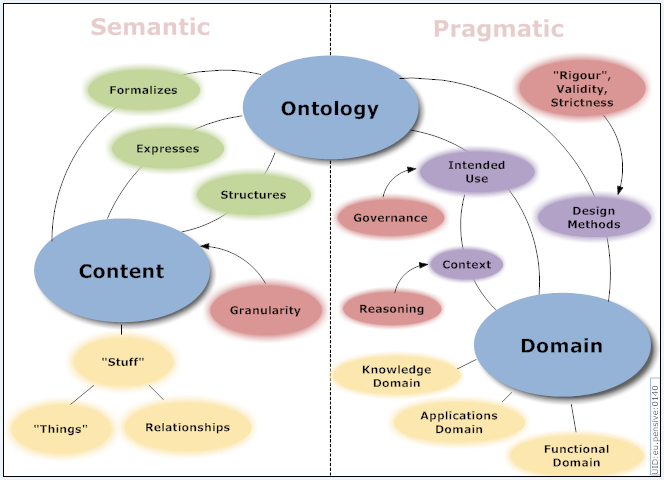Ontolog Forum
Ontology Summit 2007 Ontology Dimensions Map
This is the work product of breakout group-Z of the OntologySummit2007_Population_Session. [ ref. ]
Group-Z Members: Peter Brown, Denise Bedford, Jim Disbrow, Vincent Reboul, Jack Teller and Susan Turnbull
Source: http://ontolog.cim3.net/forum/ontology-summit/2007-04/msg00147.html
From: OntologySummit2007_Population_Session Breakout Group-Z / 2007.04.23
Our working group "Z" was scoped this afternoon to examine the "dimensions" of the proposed ontology framework.
We started by agreeing that some sort of "representation" of the "dimensions" was needed, particularly as the questions of possible co-variance and/or orthogonality between the dimensions was discussed in the session and that the dimensions were not "alike" in terms of their relationship with an ontology. We decided to create a "concept map" with limited semantics: I use the word "depicts" - it is not intended as a specification of a conceptualisation, after all ;-)
This diagram can then serve to depict and talk about the dimensions as well as give us some understanding of the implications of metrics applied to them (for example existence or degree of co-variance)
It is a "Template for Discourse" about ontologies, rather than a conceptual model of them.

[Figure 1: Ontology Dimensions Map]
Please limit interpretation of the "concept map" to the following semantics - nothing else is implied:
- (Solid blue ovals) - There are two "nodes" related to "ontology" - essentially
depicting the "what?" and the "whose?" of the ontology;
- ("Fluffy" green and lilac ovals, over a line connecting two nodes) - There are
then a series of "named arcs" or relationships/associations between nodes that depict or say something about, have or establish some relationship between two nodes - the green ones use verbs, while the lilac ones use nouns for no reason other than the fact that we didn't have time to go further: the green arcs could equally be named "formalization", "expression" and "structure";
- (Fluffy red ovals, with an unnamed directed arc pointing to a node) - There are
some nodes that say something further about another node, whether it is to qualify, explain, scope or otherwise constrain;
- (Fluffy yellow ovals, with an unnamed non-directed arc connecting with a node)
- Some nodes have an "is" or an "is a" relationship with another node
- Finally, the nodes and arcs on the left cover, we believe the issues relating
to semantic dimensions, while those on the right cover the pragmatic dimensions.
So....the big question is now: is this useful? Can it be used as a template onto which specific ontologies can be mapped and - where necessary/useful - values applied to each node or arc?
I hope that I have faithfully reproduced what we discussed and not extrapolated too far with any of the nodes or arcs: together they do capture the entirety of the dimensions and descriptions thereof in the framework statement.
Comments
... (Comments and suggestions are welcomed; please insert below)
- I'm really glad to see curves and ellipses instead of boxes and lines. I think the template will be extremely useful. Even simply as a layout showing where ontologies belong or work best, and being able to compare multiple ontologies' strengths and weaknesses in one overview. (--DeborahMacPherson / 2007.10.24-10:10 EDT)

